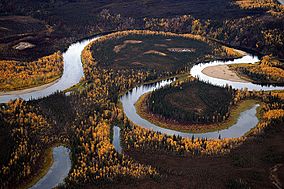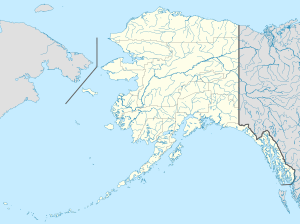Kanuti National Wildlife Refuge facts for kids
Quick facts for kids Kanuti National Wildlife Refuge |
|
|---|---|
|
IUCN Category IV (Habitat/Species Management Area)
|
|

Kanuti River in the refuge
|
|
| Location | Alaska, United States |
| Nearest city | Allakaket, Alaska |
| Area | 1,640,000 acres (6,600 km2) |
| Established | 1980 |
| Governing body | U.S. Fish and Wildlife Service |
| Website | Kanuti NWR |
The Kanuti National Wildlife Refuge is a special protected area in central Alaska, United States. It is one of 16 such refuges in Alaska. This refuge was created in 1980 by a law called The Alaska National Interest Lands Conservation Act (ANILCA).
Kanuti Refuge is huge, covering about 1,640,000 acres (6,636 km2). That's roughly the same size as the entire state of Delaware! It sits right on the Arctic Circle. This makes it a great example of Alaska's boreal ecosystem, which is a type of forest found in cold northern areas. The refuge is mostly covered with black and white spruce trees, along with some white birch and poplars.
Contents
What is the Kanuti Refuge Like?
The Kanuti Refuge has short, hot summers. During this time, there are many thunderstorms and lightning strikes. These often cause natural wildfires. While wildfires might sound scary, they are actually a normal part of this ecosystem. They help create different kinds of habitats. These varied habitats then support many different types of plants and animals.
Amazing Animals of Kanuti
The boreal forest in the refuge is home to 37 different kinds of mammals. You can find two types of fox, Canadian lynx, and both brown and black bears. There are also wolf packs, moose, and smaller animals like mink, coyotes, muskrats, and beavers. Other cool mammals include martens, river otters, muskoxen, and wolverines. Sometimes, caribou herds also spend the winter here.
Fish Life Cycle in Kanuti Waters
The refuge's waters are home to many fish, including some amazing migratory species. Chinook, chum, and coho salmon are all found here. There are also sheefish, which are known for their incredibly long journeys. Kanuti's sheefish travel farther than any other sheefish to lay their eggs (this is called spawning). The salmon here swim more than 1,000 miles (1,609 km) up the Yukon River! They then enter the Koyukuk River system to spawn. In total, twelve other fish species live in the refuge, like arctic grayling and northern pike.
Birds and Their Breeding Habitat
A very important goal of the Kanuti National Wildlife Refuge is to protect places where migratory birds can breed. The U.S. Fish and Wildlife Service works hard to make sure these birds have safe homes. Nearly 130 different kinds of birds spend part or all of the year on the refuge lands. Many wetlands (areas of land covered with water) outside of Alaska are disappearing. This makes Kanuti even more important as a nesting area for birds.
Visiting Kanuti Refuge
Some parts of the Kanuti Refuge are owned by Native Alaskan people. People are allowed to hunt for food (this is called subsistence hunting) within the refuge.
The ground in the refuge can be very wet and soft. This is because of something called Permafrost. Permafrost is ground that stays frozen all year round. It stops surface water from draining away, making hiking very difficult in some areas. There are no special trails, campsites, or public cabins inside the refuge.
Images for kids



